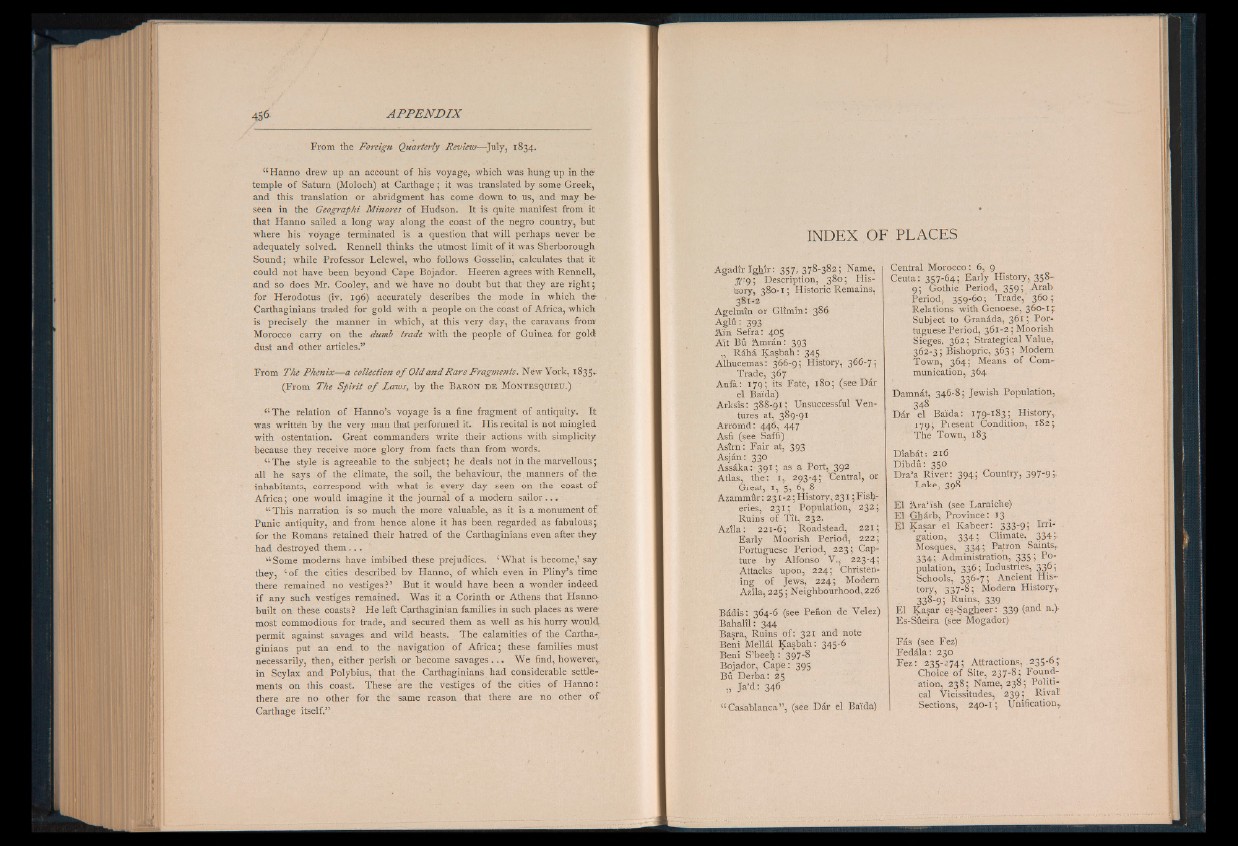
From the Foreign Quarterly Review—July, 1834.
“ Hanno drew up an account of his voyage, which was hung up in thé
temple of Saturn (Moloch) at Carthage ; it was translated by some Greek,
and this translation or abridgment has come down to us, and may be
seen in the Geographi Minores of Hudson. It is quite manifest from it
that Hanno sailed a long way along the coast of the negro country, but
where his voyage terminated is a question that will perhaps never be
adequately solved. Rennell thinks the utmost limit of it was Sherborough
Sound; while Professor Lelewel, who follows Gosselin, calculates that it
could not have been beyond Cape Bojador. Heeren agrees with Rennell,
and so does Mr. Cooley, and wè have no doubt but that they are right;
for Herodotus (iv. 196) accurately describes the mode in which thé
Carthaginians traded for gold with a people on the coast of Africa, which
is precisely the manner in which, at this very day, the caravans from
Morocco carry on the dumb trade with the people of Guinea for gold
dust and other articles.”
From The Phenix— a collection o f Old and Rare Fragments. New York, 1835.
(From The Spirit o f Laws, by the B a r o n d e M o n t e sq u ie u .)
“ The relation of Hanno’s voyage is a fine fragment of antiquity. It
was written by the very man that performed it. His recital is not mingled
with ostentation. Great commanders write their actions with simplicity
because they receive more glory from facts than from words.
“ The style is agreeable to the subject; he deals not in the marvellous ;
all he says of the climate, the soil, the behaviour, the manners of the;
inhabitants, correspond with what is every day seen on the coast o f
Africa; one would imagine it the journal of a modern sailor...
“ This narration is so much the more valuable, as it is a monument o f
Punic antiquity, and from hence alone it has been regarded as fabulous;,
for the Romans retained their hatred of the Carthaginians even after they
had destroyed them . . .
“ Some moderns have imbibed these prejudices. ‘What is become,’ say
they, ‘ of the cities described by Planno, of which even in Pliny’s time
there remained no vestiges?’ But it would have been a wonder indeed
if any such vestiges remained, Was it a Corinth or Athens that Hanno-
built on these coasts? He left Carthaginian families in such places as were-
most commodious for trade, and secured them as well as his hurry would,
permit against savages and wild beasts. The calamities o f the Carthaginians
put an end to the navigation of Africa; these families must
necessarily, then, either perish or become savages . . . We find, however,,
in Scylax and Polybius, that the Carthaginians had considerable settlements
on this coast. These are the vestiges of the cities of Hanno:
there are no other for the same reason that there are no other o f
Carthage itself.”
I N D E X O F P L A C E S
Agadir Ighîr: 357, 378-382; Name,
37-9; Description, 380; History,
380-1; Historic Remains,
381-2
Agelmin or Gltmin: 386
Aglû: 393
Aïn Sefra: 405
Ait Bû Amrán: 393
„ Ráhá Kasbah: 345
Alhucemas: 366-9; History, 366-7;
Trade, 367
Anfà: 179; its Fatè, 180; (see Dár
el Baïda)
Arksís: 388-91; Unsuccessful Ven-
tures at, 389-91
Arromd: 446, 447
Asfi (see Saffi) .
Asirn: Fair at, 393
Asján: 330
Assáka: 391 ; as a Port, 392
Atlas, the: 1,. 293-4; Central, or
Great, I , S, 6, 8
Azammûr : 231-2 ; History, 231 ; Fisheries,
231; Population, 232;
Ruins of Tit, 232.
Azila: 221-6; Roadstead, 221;
Early Moorish Period, 222 ;
Portuguese Period, 223; Capture
by Alfonso V., 223-4;
Attacks upon, 224; Christening
of Jews, ' 224; Modern
Azila, 225 ; Neighbourhood, 226
Bádis: 364-6 (see Peñón de Velez)
Bahalil : 344
Basra, Ruins of: 321 and note
Beni Mellál Kasbah: 345-6
Beni S’beeh : 397'8
Bojador, Cape: 395
Bû Derba: 25
„ Ja’d: 346
“ Casablanca” , (see Dár el Baida)
Central Morocco : 6, 9
Ceuta: 357-64; Early History, 358-
9; Gothic Period, 359; Arab
Period, 359-60; Trade, 360;
Relations with Genoese, 360-17.
Subject to Granâda, 361 ; Portuguese
Period, 361-2 ; Moorish
Sieges, 362; Strategical Value,
362-3 ; Bishopric, 363 ; Modern
Town, 364; Means of Communication,
364
Damnât, 346-8; Jewish Population, 348 Dâr el Baida: 179-183; History,.
179; Present Condition, 182;
The Town, 183
Dîabât: 216
Dihdû: 350
Dra’a River: 394; Country, 397-93
Lake, 398
El Ara’ ish (see Laraiche)
El Ghârb, Province: 13
El Kasar el Kabeer: 333-9 ; Irrigation,
334; Climate, 334 j-
Mosques, 334; Patron Saints,
334; Administration, 335 J I?0-
pulation, 336; Industries, 33^ i
Schools, 336-7; Ancient History,
337-8 ; Modern History,.
338-9; Ruins, 339
El Kasar es-Sagheer: 339 (and n.J
Es-Sûeira (see1 Mogador)
Fâs (see Fez)
Fedâla: 230
Fez: 235-274; Attractions, .235-67
Choice of Site, 237-8; Foundation,
238; Name, 238; Political
Vicissitudes, 239; Rival'
Sections, 240-1 ; Unification,